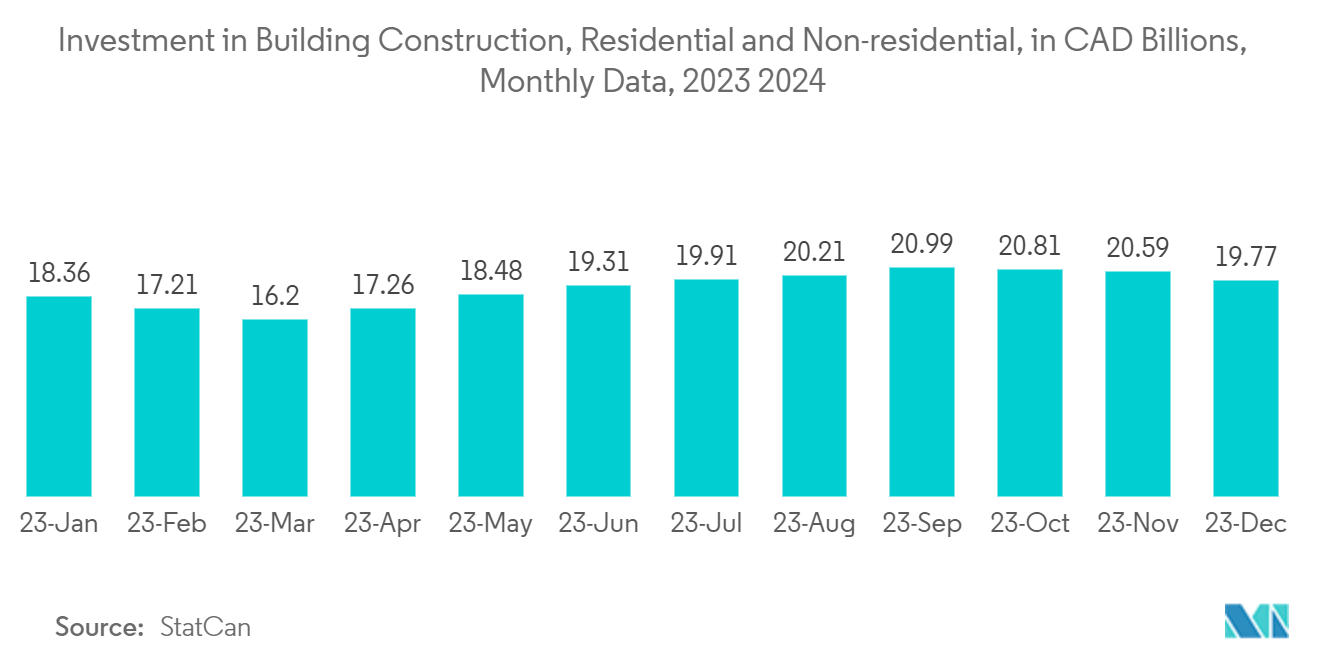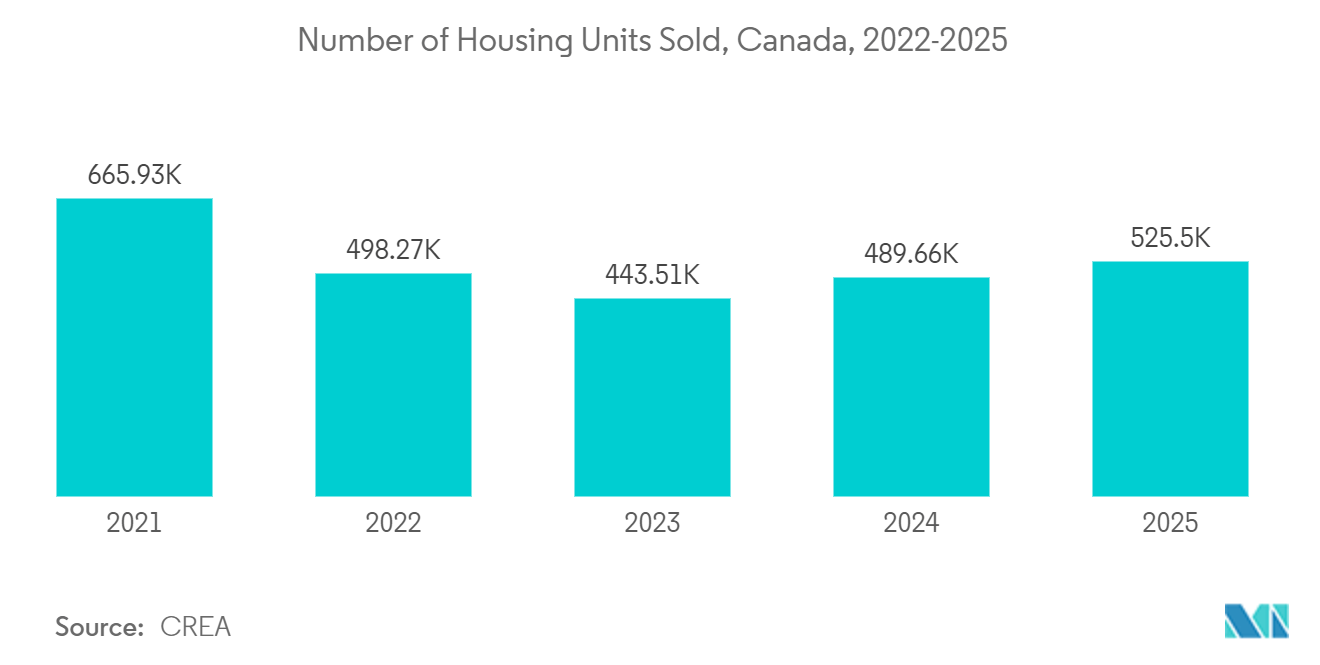Market Trends of Canada HVAC Equipment Industry
Surge in Construction Activities is Driving the Market
- The construction sector in Canada plays a significant role in propelling the demand for HVAC (Heating, Ventilation, and Air Conditioning) equipment. As the construction sector experiences growth with new residential, commercial, and industrial projects, there is a simultaneous demand for HVAC systems to provide heating, cooling, and ventilation for these buildings. HVAC equipment is essential for ensuring occupant comfort and maintaining indoor air quality in newly constructed spaces. According to FMI Corporation, construction spending for all construction projects in Canada amounted to approximately USD 360.33 billion in 2023. By 2027, it is expected to cross USD 401 billion.
- In 2024, the Canadian Prime Minister announced a package of USD 600 million for new construction technology. This includes research and development of new ideas such as prefabricated housing factories, mass timber production, 3D printing, etc. The country supports new construction tech to make it easier to build cost-effective homes faster. Such initiatives are expected to bolster the construction sector, eventually increasing the demand for HVAC equipment.
- With the rise in climate change awareness, builders and regulators alike in the region are seeking to decrease the carbon footprint of commercial and industrial construction. Construction guidelines such as Net Zero have established a standard for sustainable building practices. Heavy government subsidies also make it more affordable to meet the higher upfront costs sometimes associated with green construction.
- With the expansion of commercial sectors, including office buildings and retail spaces, there is a growing demand for HVAC equipment to provide climate control and ventilation in these facilities. As businesses expand or relocate, they often invest in new HVAC systems tailored to their needs. According to CBRE Group, Canada's new office space supply reached 6.73 million square feet in 2023.
- Building renovation projects by the government to make them more energy-efficient is significantly rising in the Canadian market. This is because energy-efficient buildings can help reduce greenhouse gas emissions, lower energy bills for homeowners and businesses, and improve indoor air quality, thus making them suitable for public health. Therefore, with the growing construction and retrofit activities, there will be a significant rise in the demand for energy-efficient HVAC equipment for maintaining comfortable indoor temperatures and good air quality in buildings, owing to support climate changes, abiding by energy regulations, technology automation, and building automation.

The Residential Segment Holds a Significant Market Share
- HVAC demand is increasing in the nation owing to an increase in the number of luxury residential infrastructure projects. Over the forecast period, additional factors, including increased urbanization and rising per capita income of consumers in emerging nations, are anticipated to generate several opportunities for market players. Total residential and nonresidential investments in January 2024 amounted to CAD 18.4 billion. In October, November, and December of 2023, investments stood at around CAD 20.8 billion, 20.59 billion, and 19.76 billion, respectively. Around 66% of the investment in January 2024 was dedicated to residential construction.
- According to CREA, the number of home sales in 2023 was recorded at 443,511, and it is expected to reach almost 525,500 by 2025. In May 2023, Lennox collaborated with its network of residential dealers to honor deserving community heroes in Canada by providing free heating or cooling equipment and installation.
- Due to tighter government controls on energy emissions from residential buildings worldwide, HVAC systems are becoming more prevalent in the residential sector. To comply with the emission laws, several market vendors continually invest in new product introductions and residential HVAC subscription programs. The Canadian government encourages consumers to buy air conditioners with Energy Star as an Energy Star-certified central air conditioner uses 8% less energy on average than a standard model. Due to such regulations, HVAC vendors offer equipment according to government standards. Due to the RTUs rule, more vendors are concentrating on commercial buildings and sustainable skyscrapers.
- Given the variable climate and harsh winters, HVAC systems have become necessary in most Canadian homes. Many places in Canada face extreme heat events or heat waves involving high temperatures and high humidity. As per the preliminary figures released by the BC Coroners Service, 619 people died from severe heat in British Columbia during the most extended summer heat wave.
- Canada is increasingly facing a housing crisis with uncertainty over unaffordable real estate prices and rents. The government is bolstering its initiatives to meet the increasing demand for real estate. As inflationary pressure subsides, the segment is expected to resume its upward trajectory. This will, in turn, increase the demand for HVAC equipment.
- In recent years, as per a survey conducted by Statistics Canada, sales of electrical, plumbing, heating, and air-conditioning equipment and supplies to wholesalers amounted to approximately CAD 38.86 billion (USD 29.12 billion) recently, and it stated that around three in five Canadian households own an air conditioner. Among them, 42% reported having a central air conditioner, 17% a stand-alone, and 3% another type of air conditioner. Also, according to A-Plus Air, around 65% of Canadian homes are warmed by forced-air furnaces, most of which are powered by natural gas, and others use propane or oil. Furnace-based heating systems are popular because they can heat a room quickly. With some modifications, a forced-air furnace can even be roped into function as an air filter, fresh-air ventilator, or humidifier. Another benefit is that the same duct systems can be deployed for air-conditioning during warmer summer months.
- In February 2023, it was announced that Wolseley Canada and GE Appliances, a Haier subsidiary, Air & Water Solutions, will collaborate to provide the Canadian market with a full line of high-end heating, ventilation, and air conditioning equipment. Furnaces, air conditioners, air handlers, heat pumps, evaporator coils, and package units are among the new residential ducted HVAC line-ups from GE Appliances Air & Water Solutions that provide the utmost in-home comfort. The latest products are expected to be offered at Wolseley Canada stores across Canada.


